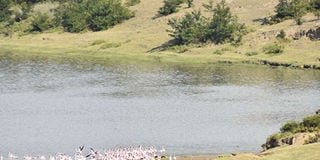Simbi Nyaima testimony to a chief’s hostility

Flamingos enjoy the waters of Lake Simbi Nyaima in Homa Bay County. Geologists believe the lake was formed as a result of tectonic movement. PHOTO | BARACK ODUOR | NATION MEDIA GROUP
What you need to know:
- The Kenya Wildlife Service website locates the lake a few kilometres from Lake Victoria, 70 kilometres from Kisumu Town.
- The lake supports a substantial bird population, including flamingos, grebes, egrets and Egyptian gees.
The origin of Lake Simbi Nyaima in Rachuonyo North Sub-County, Homa Bay County, is steeped in folklore.
It is said that the lake was formed when a village that once stood on its location was swallowed up after the village chief refused to welcome an old woman who sought a place to spend the night in the village.
“Long before the era of modernisation, the chief of a village called Simbi had a feast at his home,” recounts Mr Joshua Ochieng, a resident.
The chief invited guests who came and ate, drank and danced. When darkness fell, an old woman, who happened to be the daughter of a known rain maker, walked into the chiefs’ home.
She asked if she might be given a place to spend the night, but the chief and his visitors rudely chased her away. She was later welcomed at another home just outside Simbi.
DISASTER
Folklore has it that the old woman told her host to leave the village as disaster was about to strike. “A storm appeared from nowhere and destroyed the village after the woman left,” Mr Ochieng’ narrates.
It rained until the village sank with everyone in it, the chief and his guests, included.
The Kenya Wildlife Service website locates the lake a few kilometres from Lake Victoria, 70 kilometres from Kisumu Town.
Simbi Nyaima, in Dholuo, means “the village that swallows up people”.
The lake and the adjacent Odango support a substantial bird population, including flamingos, grebes, egrets and Egyptian geese, making them a haven for bird watchers.
CURE
It’s believed that the crater lake with calm, greenish water holds many secrets, even though there is limited activity around it.
Residents do not use its waters for domestic or agricultural purposes. Only members of the Legio Maria sect do, believing that the waters cure a variety of ailments.
Geologists believe the lake was formed as a result of tectonic movement, which resulted in volcanic eruptions.
A depression was formed and water filled the hollow to form a lake. This is said to have taken place about six centuries ago.
It’s also said that several researchers have died trying to determine the lake’s depth.
Once a year, flamingos from Lake Nakuru migrate to the lake, although their numbers have been decreasing. Currently, just few of the birds can be seen in the area.
Is there a site of historical importance that you would like us to feature? E-mail to: [email protected]





